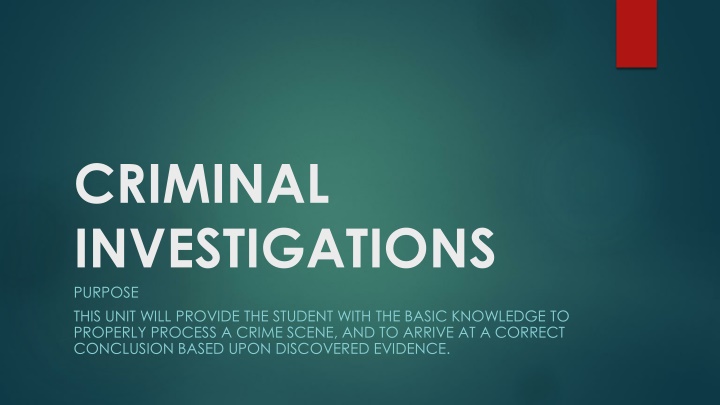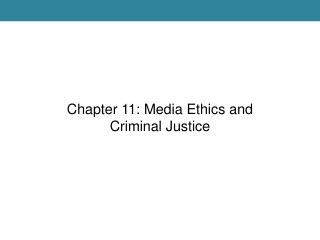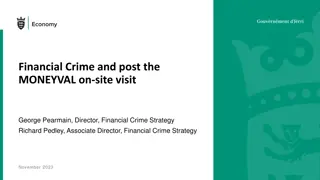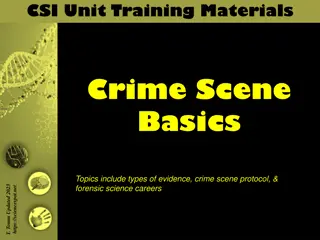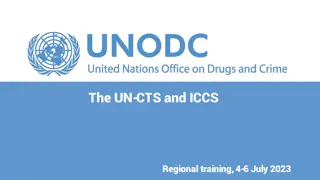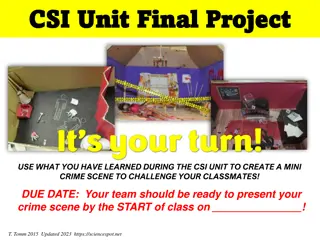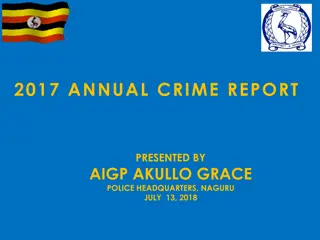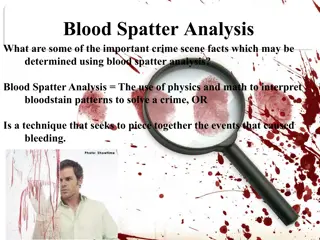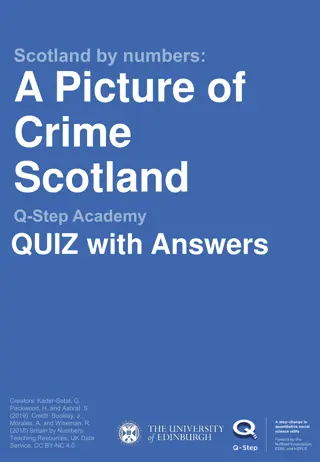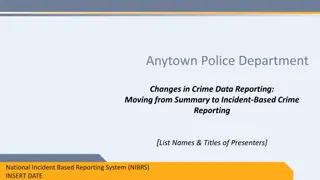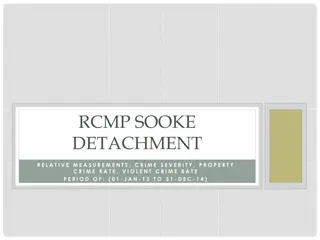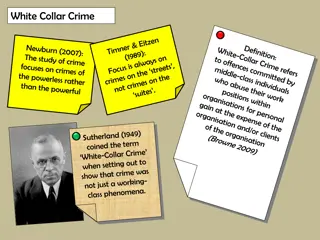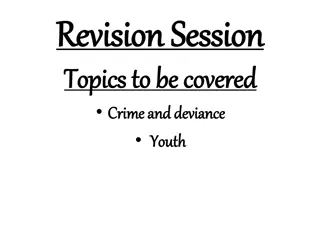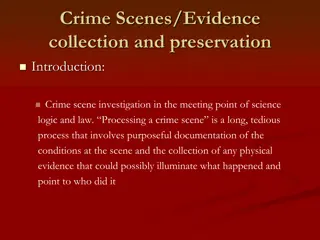Basic Knowledge for Crime Scene Processing
This unit provides essential knowledge for processing a crime scene and arriving at correct conclusions based on discovered evidence. It covers the approach of law enforcement officers, the principle of guilty until proven innocent, and the importance of protecting and preserving the crime scene.
Download Presentation

Please find below an Image/Link to download the presentation.
The content on the website is provided AS IS for your information and personal use only. It may not be sold, licensed, or shared on other websites without obtaining consent from the author.If you encounter any issues during the download, it is possible that the publisher has removed the file from their server.
You are allowed to download the files provided on this website for personal or commercial use, subject to the condition that they are used lawfully. All files are the property of their respective owners.
The content on the website is provided AS IS for your information and personal use only. It may not be sold, licensed, or shared on other websites without obtaining consent from the author.
E N D
Presentation Transcript
CRIMINAL INVESTIGATIONS PURPOSE THIS UNIT WILL PROVIDE THE STUDENT WITH THE BASIC KNOWLEDGE TO PROPERLY PROCESS A CRIME SCENE, AND TO ARRIVE AT A CORRECT CONCLUSION BASED UPON DISCOVERED EVIDENCE.
LAW ENFORCEMENT OFFICERS APPROACH The officer s approach to thinking is considerably different from that of the rest of society. During any investigation, we must believe nothing we are told. Victims lie and distort facts. Fear, insurance fraud, emotions. Witnesses lie and distort facts Persons who dislike police, suspects lie to conceal truth, emotions.
Guilty until proven innocent? Everyone is a suspect until proven otherwise. Obtain as much information as possible from everyone at the scene.
PROTECTION OF THE CRIME SCENE Treat every scene as a worst case scenario until it can be proven otherwise.
PROTECTION OF THE CRIME SCENE Paramount to any crime investigation is the protection of that crime scene to avoid destruction of evidence or alteration of the scene.
PROTECTION OF THE CRIME SCENE Preservation of life. Preservation of Life trumps preservation of evidence. Unless immediate threat of death or serious injury is present, leave all objects and animals as discovered until processing the scene. While administering life saving measures, attempt to preserve as much of the scene as possible. You may be the lead investigator in an animal case. Law enforcement is your backup, use them.
PROTECTION OF THE CRIME SCENE First arriving officer s responsibility: Protection of the crime scene: Persons entering or exiting the scene must have authorization of the officer in charge of protection of the scene. This not only includes onlookers, but also the press, family, etc. Some of the worst offenders of this are other officers who are curious (this includes brass). Without definite need to enter, they should not be allowed in. If they do enter, they take responsibility of the scene. Generally, most departments have policies governing this incident. Injured animal/human exception: Health and life are always of utmost importance, even though evidence may be destroyed. The officer should instruct paramedics as to how to enter the scene (without interfering with their work). This will limit the destruction of evidence.
PROTECTION OF THE CRIME SCENE Keep the scene in the same condition as when the suspect left: First, make an initial cursory search of the scene, being sure not to alter anything; then set up a perimeter. The crime scene will provide the investigator with a starting point. The success of an investigation and subsequent prosecution depend upon the actions of the first officer on the scene. Begin Note Taking This includes what you did (showing the five senses), what specialized units were called, and what they did, etc.
CRIME SCENE LIMITS The size of the crime scene must be determined and limits must be set to keep out potential violators. How large is the crime scene? Definition: There area that includes all direct traces of the crime as determined by the type of crime committed. Indoors The central scene and, where possible, the criminal s entry and exit paths. Outdoors An ample area should be roped off to include the suspect s paths to and from the central crime scene
CRIME SCENE LIMITS Does the individual have a purpose at the scene? If not, he/she leaves. These are gawkers, curious police, or other support personnel, who have no business there. If so, when finished he/she leaves. Examples of these are medical personnel or evidence specialists, who have specific purposes (lifting of prints, photos, etc.). Record names and addresses for later elimination purposes. This is done to sort fingerprints.
CRIME SCENE LIMITS *Safety Line *Media may enter Officers at the scene should under no circumstances give information to reporters. There should be a designated press relations officer or supervisor for that task. (Use that for a reason. Photography by media is permitted Items to remember: Do not pose. News reporters should not be allowed to photograph the crime scene without permission from the officer in charge. Press should not learn of specific clues or conditions at the crime scene that may be essential to the solution of the crime. In general, only the criminal profits from that. (Example: Destruction of evidence he/she has in his/her possession.)
CRIME SCENE LIMITS Evidence Line Everything inside this line is being protected for physical evidence. Keeps out everyone but law enforcement personnel. Crime scene violators Locard s Law applies to these also: Police, Fire, gawkers, weather, animals, etc. Locard s Law includes anybody or anything that enters or exits the crime scene. Require personnel, who have a need to enter, to do so with their hands in their pockets, and instruct them where to walk.
MOST COMMON EVIDENCE CATEGORIES: Testimony Excited utterance Statements made while still under stress from an event. Suspect, victim, or eyewitness Courts are beginning to question confessions made by defendants, as well as testimony of any eyewitness. Prosecutors realize that we need corroboration by the physical evidence. Circumstantial or indirect When a series of facts unrelated to an argument leads to a deduction that supports that argument. Physical Any type of evidence having an objective existence.
PHYSICAL EVIDENCE Physical evidence cannot lie. Essential to a successful conviction. Physical evidence can take any form. Can be as large as a house; Can be as small as a fiber; Can be as fleeting as an odor.
PHYSICAL EVIDENCE Can prove a crime was committed. Example:In the case of rape, you need to show lack of consent. Physical evidence can show this through torn clothing or injuries. Example:In the case of arson, there must be some type of combustible present in the area of ignition (gas, kerosene, etc.) Can prove a suspect was at the scene. The presence of animal hair or mud from the scene on the suspect.
Can establish the identity of persons associated with the crime. A specific M.O. (surgical gloves at scene, or a specific type of entry.) Can exonerate the innocent. Lack of drugs in the victim s bloodstream when he claims he was drugged. Can corroborate the victim s testimony. The victim s blood, prints, etc., at the scene or on the suspect. A suspect confronted with the evidence may make a confession. Physical evidence is more reliable than testimony. Physical evidence does not change, whereas, over a period of time or through talking to people, a witness may fill in areas that were not observed. Has become more important due to court cases. Courts not allowing testimony due to hearsay or violation of Miranda. Physical evidence is expected by juries. Lack of physical evidence may provide useful information. Lack of point of entry at a burglary scene, or a lack of footprints in fresh snow at the scene.
INFORMATION AND PHYSICAL EVIDENCE Considering the impossibility that everyone is a suspect, we must utilize information and physical evidence to reduce the number of suspects. Information Primary to locating a suspect: Upon arriving at a crime scene, contact possible witnesses or victims; obtain suspect information (description, direction of travel, vehicle or on foot, etc.) and broadcast it Secondary to convicting a suspect: Testimonial evidence; Identification of possible suspect through photo line-up, or positive identification if a suspect is detained.
PHYSICAL EVIDENCE Primary to convicting a suspect: Fingerprints or blood at the scene will not immediately locate a subject, but it will assist in the conviction. Secondary to locating a suspect: The same fingerprints taken at the scene may be matched and will assist in identifying a suspect and possibly obtaining a warrant.
LOCARDS LAW It is not possible to come into contact with an environment without changing it in some way, whether by adding to (prints, blood, etc.) or subtracting from (stereo, serial numbers, mud, etc.).
LOCARDS LAW An understanding of Locard s Law makes it clear that we will always have physical evidence at a crime scene. When a suspect enters a crime scene, the suspect will leave something of himself/herself and take something from the scene when exiting. Theory of Transfer is the leaving of something or taking away of something at the scene. Theory of Mutual Exchange applies to the greatest extent in the crime of rape (exchange of semen). There is also a possibility of exchange in situations of assault and a mutual exchange of blood or other body fluids.
LOCARDS LAW There will always be a transfer. Does crime scene warrant complete search? A more serious crime requires a more thorough search. This is where you, as an initial officer on the scene, have to make a determination as to how many man-hours should be spent investigating this incident. It can be as little as taking a few statements and writing a report, as much as having an evidence technician obtain prints and pictures, or as great as having detectives and Identification Section respond.
CLASS AND INDIVIDUAL CHARACTERISTICS Our process of elimination continues with the use of class and individual characteristics as tools. Tools Used For Elimination
CLASS CHARACTERISTICS True of more than one Fibers Paint Hair Blood types: Typing as is A-B-O or animal or human, but it cannot determine an individual. The exception to this rule is the DNA processing where blood can now be identified to a single person.
INDIVIDUAL CHARACTERISTICS True for only one, unique Finger, palm, and foot prints Bite marks Tool marks Blood with DNA processing
INVESTIGATIVE HYPOTHESIS To make the best use of obtained facts during an investigation, it is best to have a plan. A plan that may be used in any form of investigation is the development of an investigative hypothesis. Have a reasonable set of assumptions. As an experienced investigator, you will begin making assumptions even when dispatched to a call, due to prior experiences. Who, What, Where, When, Why, How: You should attempt to answer all of these questions on the initial contact.
INVESTIGATIVE HYPOTHESIS Base assumptions upon actual observations. After making initial contact, you develop a theory as to what occurred and how to continue. The hypothesis must be reassessed. By doing further investigation (obtaining physical evidence) and follow-up, you reassess your theory. Does the theory still stand based upon these new facts? Corroborating evidence, testimony from witnesses, etc. We don t change facts to match theory: Change theory to match facts. The theory may change based upon new facts. The theory must match new facts.
PRINCIPLES OF CRIME SCENE SEARCH To properly search a crime scene without the loss of evidence during the process, we must consider the following principles of crime scene investigation. Be thorough: If it is avoidable, do not examine an outdoor crime scene until good daylight prevails. Certain evidence that cannot be discernible in artificial light shows up quite clearly in daylight. Evidence and information of a fragile nature should be collected before material that is less likely to be destroyed.
PRINCIPLES OF CRIME SCENE SEARCH Find everything that s there. Minute trace evidence (examples: hairs, fibers, glass fragments, etc.) Ways of collection include: Specially equipped vacuums; Shaking items onto a clean sheet of paper; Cellophane tape. Take a 4 piece, press it on the suspected area and then press onto a slide. Never use transparent tape for paint chips or hair. Tape will possibly destroy the surface of the paint, and it appears metallic under the microscope. We cannot afford to lose any evidence. Remember Locard s Law. Also, never touch, change, or alter anything until identified, photographed, measured, and recorded.
PRINCIPLES OF CRIME SCENE SEARCH Be organized We save time and limit contamination When searching the scene of a crime, a method should be your guide. Proceed in a systematic manner. Searches of a crime scene, particularly when the area is extensive, presents varied problems. It is essential that proper consideration be given to all aspects of the search problems before proceeding, in order that the search can be as complete and thorough as possible (as in large areas). Assemble all personnel outside the area to be searched. Establish a team, designating specific individuals with specific responsibilities (recorder, photographer, sketcher, evidence gatherer which would include taking measurements, latents, etc.). Normally, this will be done by two people.
PRINCIPLES OF CRIME SCENE SEARCH Explain in detail the type of evidence being searched for. Inform search parties of all information you have on the crime and the importance of recovery. Impress the teams with the urgency or lack of it (evidence). Divide the personnel into groups. Assign a person to be in charge of each group and assign a recorder. Determine the method of the search. Start at the perimeter and work toward the center in a pre-described pattern.
PRINCIPLES OF CRIME SCENE SEARCH Choose a search method Several classifications of methods: Concentric or spiral search (circular) Point to point (line): Similar to circular method, sometimes better suited for special problems. Gives closer coverage over a larger percentage of the area. Area or sector search (grid) Quadrant search: divide large areas into four small areas.
PRINCIPLES OF CRIME SCENE SEARCH The number of searchers and spacing depends upon the extent of the area to be searched: Spacing short grass no brush heavy brush further apart. Type of evidence sought will also be a factor: Entire group moves together clockwise; The group will move no faster than its slowest member.
PRINCIPLES OF CRIME SCENE SEARCH Work from the perimeter: Each group must be informed if the following experts are available: Photographer; Fingerprint person; Laboratory technicians. Means of communication must be provided for groups: Radio; Megaphone; Foot-runner; Other.
PRINCIPLES OF CRIME SCENE SEARCH Vehicle search Search the exterior of vehicle first. Interior search: Divide interior into sections; Vacuum sweepings for trace evidence; Finger print last. Record all data and information in a report, including all evidence and facts obtained during the search and investigations. Include your logical conclusion concerning the incident, if you have one.
PRINCIPLES OF CRIME SCENE SEARCH Do not destroy while marking evidence. It is extremely necessary that every piece of evidence found during any type of search be marked for identification by the person who found it. The characteristics of the mark and where marked should be recorded. When to mark: Evidence should be marked at the time it is removed from its original position. Note: NO piece of evidence should be removed from where it was found until AFTER it has been photographed, measured, recorded, and entered on the sketch of the scene. Remember the Golden Rule of Homicide Investigation Never touch, change, or alter anything until identified, measured, and photographed.
PRINCIPLES OF CRIME SCENE SEARCH Once located, record potential evidence. All items that may have evidential value should be collected and recorded (notebook to report to property sheet and book) You search, you find, you record, you mark, you submit. You are maintaining the chain of evidence. 1. 2.
RECORDING A CRIME SCENE Photograph Mark Photograph Measure and Sketch Collect Photograph while collecting Use notes to document actions taken while on scene.
RECORDING A CRIME SCENE To be considered now are the means of recording a crime scene used by police, and the associated rules that make these legal in court. Crime scene notes To be presented legally in court: Must be made at the scene; Must be made while looking at the object; Must be verified at the scene; Must not be altered later.
RECORDING A CRIME SCENE Necessary items: Date and time first reported; Type of crime; Location of the crime scene and a brief description of the area; Brief description of the crime or event that led to the investigation (M.O.); Name of the complainant; Names of all officers, witnesses, investigators, and special personnel at the scene; Names of persons conducting the search and persons who took photos, prints, sketches, etc.; Weather and lighting conditions;
RECORDING A CRIME SCENE Description of the scene and surrounding areas; Description of the interior and exterior of the crime scene (type of residence, number of rooms, windows, terrain type, etc.); Description of the primary crime scene; Location of possible evidence and names of persons who collected it; Date and time of conclusion; Must be in chronological order, accurate, and complete.
RECORDING A CRIME SCENE Sketching Photos alone are not sufficient for recording a crime scene. Sketches should be made and used to complement the photos. A sketch will clarify the appearance of a crime scene and help make the scene easier to comprehend. The advantage is that sketches can be selective. It is essential that photographs be supplemented by a chart, sketch or diagram of the scene, showing the exact position of the various bits of evidence and their relation to other evidence. Illustrations of a scene or event are admissible as an aid to the court or jury. Sketches in an officer s notebook are never considered works of art, for seldom do you find an officer who has the ability to draw recognizable objects. However, admissibility is conditioned upon primarily showing that they are reasonably accurate and complete. The officer drawing the sketch should also read the measurements in order to testify to those measurements at a later time in court.
RECORDING A CRIME SCENE General rules: Show all objects bearing on the crime: Location of entrances to buildings; Location of entrances to the room where the victim was found; Type of door at each entrance (regular, screen, glass); Side of door hinges are on and the direction of the swing; Location of the victim in relation to stationary objects; Location of weapon and evidence relative to victim and stationary objects; Need two measurements to relocate objects.
RECORDING A CRIME SCENE Include objects to illustrate the condition of the scene and the location of evidence. Draw the direction of the compass (NE, SW, etc.). North should be at the top of the sketch when possible. Include the name of the person who did the sketch. Include the date; Indicate whether the sketch is to scale; if a scale is used, note which scale.
RECORDING A CRIME SCENE Methods of measurement Baseline Objects are measured from a predetermined baseline. Generally used indoors. Triangulation Where two points are known, a third may be determined. Generally used outdoors. Use permanent reference points.
RECORDING A CRIME SCENE Common errors. Measuring a distance by pacing and expressing the results in feet and inches; Relying on memory; Drawing the outlines of a room from accurate measurements and then putting furniture into the sketch by mere visual estimates. Decide what is to be sketched beforehand. Sketching cannot begin until one is sufficiently familiar with the scene. Do NOT draw things (objects) which are clearly irrelevant to the case. The advantage of sketching over photography is that the sketch contains only the essentials, whereas the photograph often is overcrowded.
RECORDING A CRIME SCENE Photography Photographs provide a good method of reproducing the crime scene and perspective. However, the scene should first be preserved in its original, undisturbed state. To record the scene in its original state at the time of discovery, photographs should be taken. Keep all persons out of the picture. Photographs should be supplemented by detailed notes. DO NOT DELETE ANY PHOTOGRAPHS TAKEN. As a general rule, everything that is to be seized from the scene should be included in the photo before it is removed.
RECORDING A CRIME SCENE Originals must not be edited!
RECORDING A CRIME SCENE Structures The exterior of any structure should be photographed, with particular attention paid to all entrances and any signs of forced entry. A close examination should be made of all windows and doors to determine if they were open or closed, locked or unlocked.
RECORDING A CRIME SCENE Photos should be taken as follows: Exterior: A distance shot of the genera area (markers, buildings, etc.); A shot of the point of entry into the crime scene (looking towards the scene); A shot of the immediate scene (preferably from the point of entry); Pictures of all bits of evidence (and their positions in relation to other evidence); A shot from the immediate scene towards the point of exit; A shot of the point of exit, if known.
